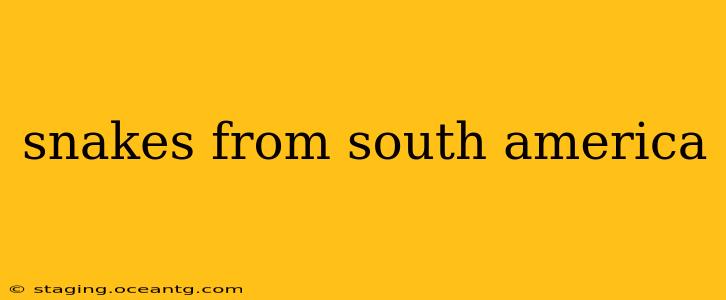South America, a continent bursting with biodiversity, is home to a remarkable array of snake species. From the colossal Anaconda to the venomous Bushmaster, these reptiles play crucial roles in their ecosystems, captivating scientists and enthusiasts alike. This exploration delves into the fascinating world of South American snakes, covering their diversity, habitats, and unique characteristics. We'll also address some frequently asked questions surrounding these incredible creatures.
What are some of the most common snakes found in South America?
South America boasts a vast array of snakes, making a definitive "most common" list challenging. Prevalence varies greatly by region and habitat. However, several species are widespread and frequently encountered. These include various species of Colubrids, a large family of mostly non-venomous snakes that occupy diverse ecological niches. Boa constrictors, particularly the Common Boa (Boa constrictor), are also relatively common across various South American countries. In specific regions, venomous species like certain coral snakes and fer-de-lance vipers are more prevalent. It's crucial to remember that encountering a snake, regardless of its commonality, requires respect and caution.
What is the largest snake in South America?
The undisputed champion in size among South American snakes is the Green Anaconda (Eunectes murinus). These massive constrictors can reach lengths exceeding 20 feet and weigh over 500 pounds, making them some of the heaviest snakes in the world. They inhabit swamps, rivers, and other aquatic habitats across the Amazon Basin and Orinoco River basin. While incredibly powerful, Green Anacondas are generally shy and avoid human interaction.
Are there poisonous snakes in South America?
Yes, South America is home to a significant number of venomous snakes. Among the most dangerous are the Bushmaster (Lachesis muta), a large, highly venomous pit viper; several species of coral snakes, known for their vibrant coloration and potent neurotoxic venom; and various fer-de-lance vipers, responsible for a considerable number of snakebites in Central and South America. It is vital to exercise caution and avoid handling any snake you encounter, as accurate identification of venomous species often requires expertise.
What are some of the most venomous snakes in South America?
Determining the "most" venomous is complex, as venom potency varies, and the impact depends on factors like the amount injected, the victim's size, and the availability of antivenom. However, the Bushmaster and certain coral snake species consistently rank among the most dangerous due to their highly potent neurotoxic venom and large fangs. The Fer-de-lance also poses a significant threat due to its aggressive nature and prevalence in populated areas. Again, it’s crucial to reiterate the importance of avoiding contact with any snake, especially in areas where venomous species are known to exist.
How can I identify venomous snakes in South America?
Identifying venomous snakes requires expertise, and attempting to do so based on visual cues alone can be incredibly dangerous. While some venomous snakes possess distinct characteristics (like pit viper heat-sensing pits), relying on these features for identification is unreliable and risky. The best course of action is to avoid handling any snakes, and if a bite occurs, seek immediate medical attention at a facility equipped to deal with venomous snakebites.
What should I do if I encounter a snake in South America?
Encountering a snake in South America, especially in the wild, should be treated with respect and caution. Maintain a safe distance, avoid sudden movements or attempts to handle the snake, and allow it to move away undisturbed. If you're concerned about a venomous snake in a populated area, contact local authorities or wildlife specialists. Never attempt to handle a snake unless you are a trained professional.
Conclusion
The snake diversity of South America is a testament to the continent's rich biodiversity. While these reptiles play essential ecological roles, caution is paramount when encountering them. This article aims to provide valuable information to enhance understanding and promote responsible interaction with these fascinating creatures. Remember, appreciation and respect are key to coexistence.
